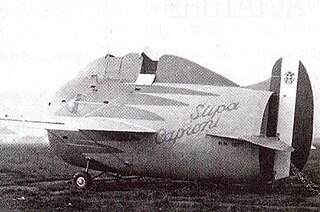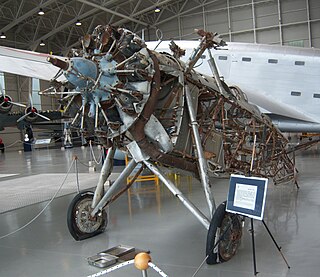
Caproni, also known as Società de Agostini e Caproni and Società Caproni e Comitti, was an Italian aircraft manufacturer. Its main base of operations was at Taliedo, near Linate Airport, on the outskirts of Milan.

The Caproni Ca.60 Transaereo, often referred to as the Noviplano (nine-wing) or Capronissimo, was the prototype of a large nine-wing flying boat intended to become a 100-passenger transatlantic airliner. It featured eight engines and three sets of triple wings.

The Caproni Ca.100 was the standard trainer aircraft of the Regia Aeronautica in the 1930s. Large numbers of this tandem, two-seat, biplane were built, powered by different engines.

The Caproni Ca.1 was an experimental biplane built in Italy in 1910. It was the first aircraft to be designed and built by aviation pioneer Gianni Caproni, although he had previously collaborated with Henri Coandă on sailplane designs.

The Caproni Ca.164 was a training biplane produced in Italy shortly prior to World War II. It was a largely conventional biplane intended as a follow-on to the Ca.100 and sharing that aircraft's layout with a slightly smaller upper wing.

The Stipa-Caproni, also known as the Caproni Stipa, was an experimental Italian aircraft designed in 1932 by Luigi Stipa (1900–1992) and built by Caproni. It featured a hollow, barrel-shaped fuselage with the engine and propeller completely enclosed by the fuselage—in essence, the whole fuselage was a single ducted fan. Although the Regia Aeronautica was not interested in pursuing development of the Stipa-Caproni, its design influenced the development of jet propulsion.

The Caproni Trento F.5 was a small Italian two-seat trainer designed by Stelio Frati and built by Aeroplani Caproni Trento. The F.5 was not ordered into production and only a prototype was built.

The Gianni Caproni Museum of Aeronautics is Italy's oldest aviation museum, as well as the country's oldest corporate museum. It was established in 1927 as the Caproni Museum by Italian aviation pioneer and aeronautical engineer, Giovanni Battista "Gianni" Caproni and his wife, Timina Guasti Caproni.
The Caproni Ca.131 was a prototype for a large aircraft built in Italy in 1934, intended for use as either a bomber or airliner. It was a conventional low-wing cantilever monoplane, powered by a radial engine on each wing and in the nose. The main undercarriage was housed within large streamlined spats. Configured as an airliner, it would have seated 17 passengers.

The Caproni Ca.87 was an Italian flying boat built in the 1920s for a planned transatlantic flight.

The Caproni Ca.16 was a single-engine monoplane designed and built by Caproni in the early 1910s.
The Caproni Ca.10 was a single-engine monoplane designed and built by Caproni in the early 1910s.

The Caproni Ca.9 was a single-engine monoplane designed and built by Caproni in the early 1910s.

The Caproni Ca.6 was a single-engine biplane designed and built by Caproni in the early 1910s.

The Caproni Ca.11 was a single-engine monoplane designed and built by Caproni in the early 1910s.

The Caproni Ca.12 was a two-seater single-engine monoplane built by Caproni in the early 1910s.

The Caproni Ca.13 was a two-seater single-engine monoplane built by Caproni in the early 1910s.

The Caproni Ca.53 was an Italian prototype light bomber built in the last months of World War I.

The Piaggio P.IX, or Piaggio Stella P.IX, was an Italian nine-cylinder radial aircraft engine produced by Rinaldo Piaggio S.p.A. Based on the Gnome-Rhône 9K, the engine was rated at 600 hp (447 kW). Production was used to power a number of other aircraft developed in Italy. The main users were the Savoia-Marchetti SM.81 transport and the IMAM Ro.37bis, the main reconnaissance aircraft in the Regia Aeronautica during the Second Italo-Ethiopian War, Spanish Civil War and Second World War, but the engine was also used by other designs, including the prototype Savoia-Marchetti SM.79.

The Macchi M.20 was a single-engine biplane trainer aircraft produced by the Italian aeronautical company Aeronautica Macchi between the end of the 1910s and the beginning of the 1920s.



















